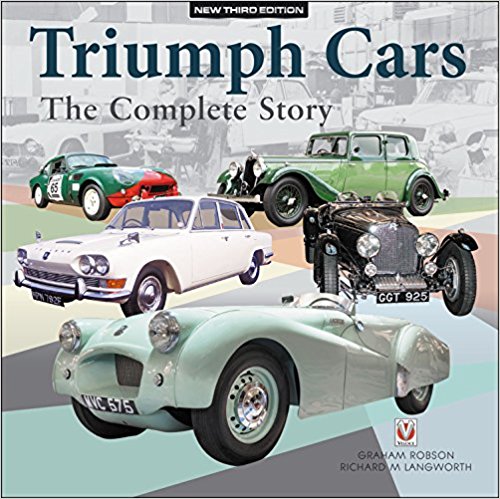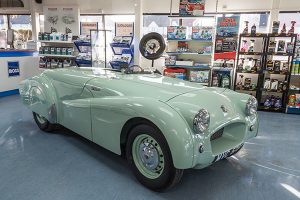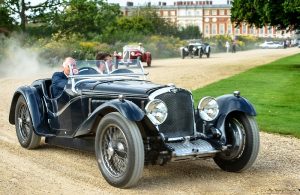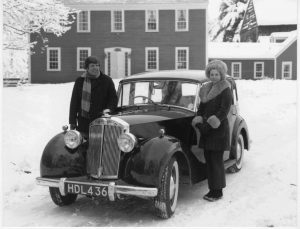
Just Published! “Triumph Cars”: Tribute to a famous British marque
A True Triumph
We are bowled over by the sheer volume of color, beauty and depth of photographs in the latest and greatest edition of Triumph Cars: The Complete Story. Largely this was the effort of my co-author Graham Robson, but I never expected such a high quality treatment by the publishers. A big, square format, 10×10 inches, it’s chock-a-block with lavish illustrations from the first spindly Triumph 10/20 of 1923 to the last, badge-engineered Triumph Acclaim of 1984. There are even appendices on Triumph-derived cars like the Bond Equipe, Amphicar, Peerless and Swallow Doretti. There is a full account of Triumph’s remarkable racing and rally performances. It’s the most luxurious production anyone could ask for. Order your copy here.
Triumph Cars is one of the best car books Graham and I wrote. It’s as thorough as it is because when we began work, in the mid-1970s, we could still find and interview so many old Triumph hands. They began with Walter Belgrove, who skillfully designed many of the best pre-World War II models, and the famous TR3. Not widely known, Donald Healey was also associated with Triumph, and accounted for one of its most legendary cars, the straight-eight Dolomite (see below). We spent many hours with Alick Dick, whose management saved the company in the early Sixties. We benefitted from interviews with Harry Webster, and many other Triumph engineers.
Triumph Cars: from the Publisher

“Relating the story of Triumph is complex enough. To include all the earlier events which persuaded Siegfried Bettmann to begin car manufacture in 1923 is even more so. The authors, however, are experts in all things Triumph: the cars, and the political events surrounding them. They have assembled and presented an enthralling story of the way the car-making business came to prosper. Triumph was then afflicted by financial problems. In 1940 its factory was bombed flat in the Coventry Blitz. It was rescued from oblivion by Standard in 1944. Thereafter, Triumph again became a prominent marque, eventually dominated Standard, and (from the 1960s onwards) became an important cast member in the melodramatic events which involved British Leyland.
“Triumph Cars: The Complete Story is not merely a turbulent trawl through the historical record. The authors were also successful in locating the important characters whose efforts made it possible for Triumph to excite the world. Along the way, the career of cars as famous as the Glorias and Dolomites of the 1930s, the Heralds, Spitfires and TRs of the postwar years, and the headline-grabbing exploits in racing and rallying build up a story which no fictional writer could have created.”
“Graham Robson
…possesses a worldwide reputation as a motoring historian, and has been close to the sport of rallying for many years as a competitor, team manager, organizer, reporter, commentator and observer. In more than forty years he has never lost touch with the sport. Not only has Graham competed in many British and European events. He’s also reported on marathons in South America, and acted as a traveling controller in the legendary London-Mexico World Cup Rally. As a recognized authority on many aspects of classic cars and motoring of that period, he is the most prolific of all authors, with more than 130 published books to his credit. Over the years Graham has owned, driven, described and competed in many of the cars featured in the Rally Giants Series, and his insight to their merits is unmatched. Graham Robson lives and works in Dorset, England.

“Graham’s tenacious efforts to see Triumph Cars back into print is the reason this handsome new edition exists. Almost singlehandedly, he rounded up dozens of new color photographs, updated the text with new information. I wrote the prewar chapters of the book. But Graham updated the story of the fabulous 1934 Dolomite Straight Eight, since discovered and fully restored: ‘The Big One that Got Away.’
“Richard Langworth

…has been an automotive writer since 1969, when he sent a freelance article to Automobile Quarterly. He joined AQ as associate and later senior editor in 1970-75. He has since written or co-authored more than fifty books and 2000 articles on automotive history. Richard and Barbara Langworth have owned ten Triumphs from a 1938 Dolomite to an assortment of Mayflowers, Renowns and TRs. In 1975, he and several friends founded the Vintage Triumph Register, thinking the time had come for a club devoted to every model motorcar Triumph ever built.
“Langworth’s other interest is Winston Churchill. In 1968 he founded what became The International Churchill Society, serving as president or chairman for ten years and editor of its journal, Finest Hour, for 35 years. In 2014 he joined Hillsdale College as senior fellow for The Churchill Project. The project sponsors educational programs and online courses, and is completing Churchill’s official biography. Richard has written or edited nine books on Churchill. In 2016 he melded his two interests in an article, “Blood Sweat and Gears,” on Churchill’s cars for The Automobile. Richard and Barbara Langworth have hosted eighteen automotive or Churchill tours of England, Scotland, France and Australia, including the 1978 Triumph tour of Britain.”
This is a book…

…for nuts who like quirky English cars. Hard to admit, but Ferraris bore me. Just unaffordable excellence. My fun derives from funky Britishers that ride hard and smell of oil. They just don’t make cars like that anymore. This abnormality is not uncommon. My old friend Rich Taylor captured it perfectly in his 1978 book, Modern Classics:
To understand British cars, you have to realize that all the stereotypes fit. I know, for example, that rated on an absolute scale, a Triumph or MG or Healey is not a great car, the way a Mercedes or Ferrari or Maserati is a great car. But I don’t care. There is something about the very Britishness of their going that makes the way other people look at you, the way the rain beads on the hood, the elegant way you feel when you’re sitting in one, considerably more important than how fast it will go.
British cars are for the sort who get out and tinker on Sunday mornings, not those with legions of mechanics. While you can have a short, passionate affair with a Lancia, or a successful marriage with a Lamborghini, it’s hard actually to love them. But a Triumph has the kind of looks, the teasing kind of humor, that keeps you on your toes; the wonderful unpredictability that is something to anticipate.
See also: “Memories of The Vintage Triumph.“







2 thoughts on “Just Published! “Triumph Cars”: Tribute to a famous British marque”
I asked my co-author Graham Robson, who writes: “No, there was never any such thing as a ‘Triumph Duvall,’ not even a private-enterprise one-off.” We think you may be thinking of the 1963 Dové GTR4, which is in our book. It was designed by a Triumph dealer, L.F. Dove & Company of Wimbledon, and constructed by coachbuilder Thomas Harrington of Hove. A gran turismo conversion of the TR4 roadster, it was similar to but IMO not as slick looking as Harrington’s Le Mans GT conversion of the Sunbeam Alpine. At least 50 and probably more were built.
Do you guys know anything about 1975 triumph Duvall?
Comments are closed.